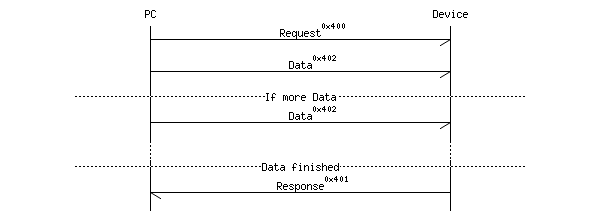This library allows a device access with the Hermes Parameterinterface over the Controller Area Network (CAN). All communication is done with four CAN-Message identifiers. The Base-Address is defined in the global const cui16_CANBaseAddress which must be set in Project. An additional address defined in const cui16_CANBroadcastAddress is used for automatic connection to the PC-Software.
To interact with the hardware to send telegrams, the function CAN_SendTelegram has to be implemented:
void CAN_SendTelegram(uint8_t data_length, uint8_t *data, uint16_t id_value)
Send CAN Message to transmit Buffer.
Definition: CAN_Para_STM32.c:41
In the Receive-Interrupt the here defined function CAN_Para_ReceiveIRQ has to be called from hardware-driver.
CAN-Messages used for Parameter-Interface
Connect from PC (command 1)
PC tries to connect the Device.
- Address: Base-ID
- DLC: 2
- Data[0]: running request ID
- Data[1]: Command-Identifier, always 1 for this command
Answer from Device
- Address: Base-ID + 1
- DLC: 4
- Data[0]: running request ID (same as in request)
- Data[1]: Command-Identifier, always 1
- Data[2]: spare, always 0
- Data[3]: Version of the Interface Specification. This is Version 6
The Connection is established, all other commands can be used from now on.
Read one SubID (command 2)
PC wants to read one single sub-ID of one Parameter.
- Address: Base-ID
- DLC: 6
- Data[0]: running request ID
- Data[1]: Command-Identifier, always 2 for this command
- Data[2-3]: Parameter-ID
- Data[4-5]: Sub-ID
Answer from Device
- Address: Base-ID + 1
- DLC: 4-8 (depends on datatype)
- Data[0]: running request ID (same as in request)
- Data[1-2]: Data-length in bytes
- Data[3-7]: Data (length can be 1-5 bytes, depending on data-type)
If Data length that have to be transferred is more than 5 bytes, additional follow-up telegrams are sent without request. If more than 255 follow-up telegrams are neccessary, the running counter can overflow.
- Address: Base-ID + 3
- DLC: 3-8 (depends on amount of data)
- Data[0]: running request ID (same as in request)
- Data[1]: running counter of follow-up telegram starting with 0
- Data[2-7]: Data (length can be 1-6 bytes, depending on data-type)
Write of one Sub-ID (command 3)
PC wants to write one single sub-ID of one Parameter.
- Address: Base-ID
- DLC: 8
- Data[0]: running request ID
- Data[1]: Command-Identifier, always 3 for this command
- Data[2-3]: Parameter-ID
- Data[4-5]: Sub-ID
- Data[6-7]: Data length in Bytes
The Data is transmitted in follow-up telegrams without any answer between the telegrams. If more than 255 follow-up telegrams are neccessary, the running counter can overflow.
- Address: Base-ID + 2
- DLC: 3-8 (depends on datatype / amount of data)
- Data[0]: running request ID (same as in request)
- Data[1]: running counter of follow-up telegram starting with 0
- Data[2-7]: Data (length can be 1-6 bytes, depending on data-type)
Answer from Device
- Address: Base-ID + 1
- DLC: 4-8 (depends on datatype)
- Data[0]: running request ID (same as in request)
- Data[1-2]: Data-length in bytes, always 0 to signalize a status code transmission.
- Data[3]: Error-Code, 0 to signalize success
Read all SubIDs (command 4)
PC wants to read all sub-IDs of one Parameter.
- Address: Base-ID
- DLC: 4
- Data[0]: running request ID
- Data[1]: Command-Identifier, always 4 for this command
- Data[2-3]: Parameter-ID
Answer from Device
- Address: Base-ID + 1
- DLC: 4-8 (depends on datatype/amount of data)
- Data[0]: running request ID (same as in request)
- Data[1-2]: Data-length in bytes
- Data[3-7]: Data (length can be 1-5 bytes, depending on data-type/amount of data)
If Data length that have to be transferred is more than 5 bytes, additional follow-up telegrams are sent without request. If more than 255 follow-up telegrams are neccessary, the running counter can overflow.
- Address: Base-ID + 3
- DLC: 3-8 (depends on amount of data)
- Data[0]: running request ID (same as in request)
- Data[1]: running counter of follow-up telegram starting with 0
- Data[2-7]: Data (length can be 1-6 bytes, depending on data-type)
Read Memory Area (command 5)
PC wants to read a Memory-Area. The Memory Area must be allowed (see Parameterinterface).
- Address: Base-ID
- DLC: 8
- Data[0]: running request ID
- Data[1]: Command-Identifier, always 5 for this command
- Data[2-5]: Address of the Memory Area
- Data[6-7]: length of the Memory Area
Answer from Device
- Address: Base-ID + 1
- DLC: 4-8 (depends on datatype/amount of data)
- Data[0]: running request ID (same as in request)
- Data[1-2]: Data-length in bytes
- Data[3-7]: Data (length can be 1-5 bytes, depending on data-type/amount of data)
If Data length that have to be transferred is more than 5 bytes, additional follow-up telegrams are sent without request. If more than 255 follow-up telegrams are neccessary, the running counter can overflow.
- Address: Base-ID + 3
- DLC: 3-8 (depends on amount of data)
- Data[0]: running request ID (same as in request)
- Data[1]: running counter of follow-up telegram starting with 0
- Data[2-7]: Data (length can be 1-6 bytes, depending on data-type)
Ping from Device for Autoconnect
The Device can optionally send ping-telegrams, which triggers a connect request from all connected PCs. With this Ping-Telegram the PC can monitor, which devices are present on CAN-Bus if thge CAN-Address of the Device is not known.
- Address: Broadcast-ID (normally 0x7F0)
- DLC: 3
- Data[0]: Version of CAN Parameterinterface
- Data[1-2]: Base Address
Error
In case of an Error on Device as answer of one of the previous defined messages
- Address: Base-ID + 1
- DLC: 3
- Data[0]: running request ID (same as in request)
- Data[1-2]: reserved, always 0
- Data[3]: Error Code
The following Error Codes are defined:
- 1: The Parameter-ID is not found
- 2: Memory Area is not permitted to read






